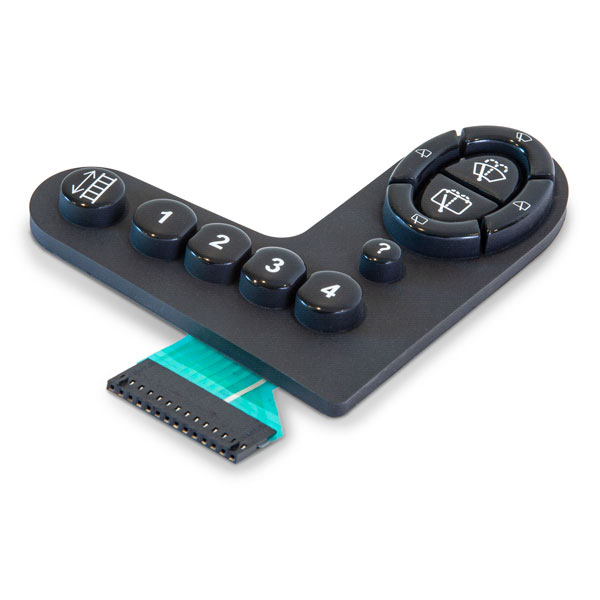Explore the Benefits of Using a Membrane Switch in Modern Devices
Explore the Benefits of Using a Membrane Switch in Modern Devices
Blog Article
Recognizing Membrane Switches: The Trick to Sturdy and Trusted Controls

What Are Membrane Buttons?
Membrane buttons are an innovative option in the realm of individual interface innovation, integrating capability and style seamlessly. These tools function as an interface between customers and digital systems, integrating numerous elements into a compact layout. Normally created from adaptable, slim layers of products, membrane switches are designed to react to touch, enabling individuals to connect with machinery and digital devices properly.
The primary components of a membrane button include a published circuit layer, graphic overlay, and a spacer layer that protects against unintended activation. The visuals overlay can be tailored to reflect brand identification or user preferences, boosting looks while making certain use. Membrane layer buttons are commonly used in different applications, including clinical devices, customer electronic devices, and industrial devices, owing to their longevity and resistance to ecological elements such as dampness and dirt.
Among the crucial benefits of membrane layer buttons is their ability to withstand damage, making them perfect for high-traffic environments. Furthermore, they are light-weight and require minimal space, enabling ingenious layouts in item growth. In general, membrane layer switches over represent a functional and efficient selection for modern digital interfaces, weding technology with user-centric design principles.
How Membrane Layer Switches Over Job
The operation of membrane changes joints on an easy yet reliable system that converts customer input into electronic signals. When a customer presses the button, the leading layer warps, permitting a conductive element in the circuit layer to make contact with an equivalent conductive pad on the underside of the graphic overlay.
The layout of membrane switches can vary, yet they often integrate domes or tactile components to provide responses to the individual, improving the overall experience - membrane switch. The materials made use of in membrane layer buttons, such as polyester or polycarbonate, contribute to their longevity and resistance to ecological variables, including moisture and dust. The published circuits are normally enveloped, which secures them from wear and tear over time.
Advantages of Membrane Switches

Furthermore, membrane switches are known for their durability. Constructed from robust products, they are immune to dust, moisture, and physical wear, which dramatically expands their life-span compared to standard mechanical switches. This longevity makes them especially suitable for high-traffic environments and applications requiring durability.
Another considerable advantage is the simplicity of cleansing and maintenance. The smooth surface area of membrane switches over decreases dirt build-up and is commonly invulnerable to spills, making them ideal for settings that call for constant sanitization.
In addition, membrane buttons offer a structured profile, causing a thinner style that can be incorporated right into various gadgets without including mass. This attribute not only improves the visual charm but also adds to an extra ergonomic item design.
Applications of Membrane Switches
Straightforward and versatile, membrane layer buttons find applications throughout a large range of industries, including medical gadgets, consumer electronics, and commercial equipment. In the clinical field, these switches are integral to gadgets such as analysis equipment, individual monitoring systems, and infusion pumps, where dependability and convenience of cleaning are important. Their capacity to withstand extreme settings and maintain performance makes them ideal for such applications.

In consumer electronics, membrane layer switches are utilized in items check my site like microwaves, washing makers, and push-button controls - membrane switch. Their streamlined design permits user-friendly customer interfaces, enhancing the total customer experience useful content while providing durability and resistance to tear and wear
Commercial equipment likewise takes advantage of membrane layer switches, specifically in control panels for equipment and automation systems. These switches use security versus dust and wetness, making certain consistent efficiency in challenging environments. Their adjustable attributes permit producers to customize them to particular operational needs, improving performance and capability.
Selecting the Right Membrane Switch
When picking a membrane layer button, it is essential to consider various factors that affect performance and suitability for particular applications. The primary factors to consider consist of ecological problems, responsive comments, toughness, and layout specifications.
First, assess the operating environment; buttons subjected to moisture, chemicals, or severe temperatures need certain materials to make sure durability and capability. Next, examine the need for tactile feedback. Depending on individual communication, some applications might gain from a tactile action to verify activation, while others might favor a non-tactile layout for visual factors.
Longevity is one more critical variable; membrane buttons need to be created to withstand regular use, impacts, and abrasion. Guarantee the selected switch can endure the expected lifecycle, especially in high-usage situations.

Conclusion
To conclude, membrane layer switches over act as vital elements in the layout of durable and trusted control systems click for source across different markets. Their compact layout, combined with durable building and personalized functions, boosts customer communication while ensuring durability popular environments. The convenience of membrane switches permits customized services that satisfy particular functional requirements, enhancing their relevance in modern-day innovation. As industries remain to develop, the relevance of integrating efficient membrane layer switch services can not be overstated.
Membrane changes stand for a critical facet of modern user interface design, mixing performance with durability in various applications.Membrane buttons are an innovative remedy in the world of customer interface modern technology, combining capability and layout seamlessly. Usually built from versatile, thin layers of materials, membrane switches are made to react to touch, making it possible for customers to connect with equipment and digital gadgets successfully.
The style of membrane layer buttons can vary, however they typically integrate domes or tactile elements to give responses to the customer, boosting the general experience.In final thought, membrane switches offer as necessary elements in the design of dependable and resilient control systems throughout different markets.
Report this page